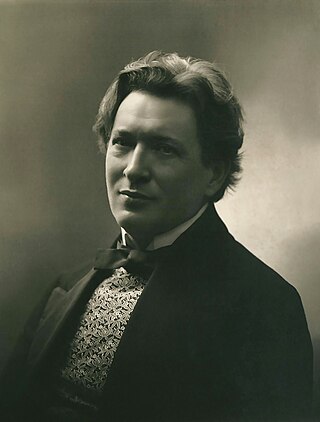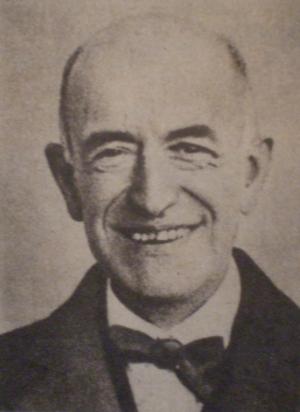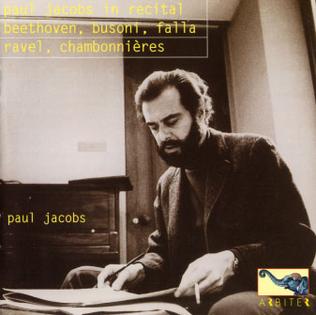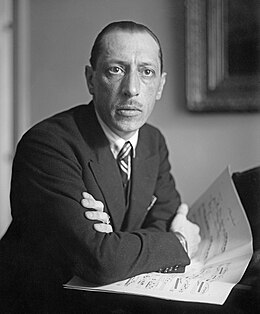People and works
Although the term "neoclassicism" refers to a twentieth-century movement, there were important nineteenth-century precursors. In pieces such as Franz Liszt's À la Chapelle Sixtine (1862), Edvard Grieg's Holberg Suite (1884), Pyotr Ilyich Tchaikovsky's divertissement from The Queen of Spades (1890), George Enescu's Piano Suite in the Old Style (1897) and Max Reger's Concerto in the Old Style (1912), composers "dressed up their music in old clothes in order to create a smiling or pensive evocation of the past". [1]
Sergei Prokofiev's Symphony No. 1 (1917) is sometimes cited as a precursor of neoclassicism. [2] Prokofiev himself thought that his composition was a "passing phase" whereas Stravinsky's neoclassicism was by the 1920s "becoming the basic line of his music". [3] Richard Strauss also introduced neoclassical elements into his music, most notably in his orchestral suite Le bourgeois gentilhomme Op. 60, written in an early version in 1911 and its final version in 1917.
Ottorino Respighi was also one of the precursors of neoclassicism with his Ancient Airs and Dances Suite No. 1, composed in 1917. Instead of looking at musical forms of the eighteenth century, Respighi, who, in addition to being a renowned composer and conductor, was also a notable musicologist, reached back to Italian music of the sixteenth and seventeenth centuries. His fellow contemporary composer Gian Francesco Malipiero, also a musicologist, compiled a complete edition of the works of Claudio Monteverdi. Malipiero's relation with ancient Italian music was not simply aiming at a revival of antique forms within the framework of a "return to order", but an attempt to revive an approach to composition that would allow the composer to free himself from the constraints of the sonata form and of the over-exploited mechanisms of thematic development. [5]
Igor Stravinsky's first foray into the style began in 1919/20 when he composed the ballet Pulcinella , using themes which he believed to be by Giovanni Battista Pergolesi (it later came out that many of them were not, though they were by contemporaries). American Composer Edward T. Cone describes the ballet “[Stravinsky] confronts the evoked historical manner at every point with his own version of contemporary language; the result is a complete reinterpretation and transformation of the earlier style". Later examples are the Octet for winds, the "Dumbarton Oaks" Concerto, the Concerto in D, the Symphony of Psalms, Symphony in C, and Symphony in Three Movements, as well as the opera-oratorio Oedipus Rex and the ballets Apollo and Orpheus , in which the neoclassicism took on an explicitly "classical Grecian" aura. Stravinsky's neoclassicism culminated in his opera The Rake's Progress , with a libretto by W. H. Auden. [7] Stravinskian neoclassicism was a decisive influence on the French composers Darius Milhaud, Francis Poulenc, Arthur Honegger and Germaine Tailleferre, as well as on Bohuslav Martinů, who revived the Baroque concerto grosso form in his works. [8] Pulcinella, as a subcategory of rearrangement of existing Baroque compositions, spawned a number of similar works, including Alfredo Casella's Scarlattiana (1927), Poulenc's Suite Française, Ottorino Respighi's Ancient Airs and Dances and Gli uccelli , [9] and Richard Strauss's Dance Suite from Keyboard Pieces by François Couperin and the related Divertimento after Keyboard Pieces by Couperin , Op. 86 (1923 and 1943, respectively). [10] Starting around 1926 Béla Bartók's music shows a marked increase in neoclassical traits, and a year or two later acknowledged Stravinsky's "revolutionary" accomplishment in creating novel music by reviving old musical elements while at the same time naming his colleague Zoltán Kodály as another Hungarian adherent of neoclassicism.
A German strain of neoclassicism was developed by Paul Hindemith, who produced chamber music, orchestral works, and operas in a heavily contrapuntal, chromatically inflected style, best exemplified by Mathis der Maler . Roman Vlad contrasts the "classicism" of Stravinsky, which consists in the external forms and patterns of his works, with the "classicality" of Busoni, which represents an internal disposition and attitude of the artist towards works. [12] Busoni wrote in a letter to Paul Bekker, "By 'Young Classicalism' I mean the mastery, the sifting and the turning to account of all the gains of previous experiments and their inclusion in strong and beautiful forms". [13]
Neoclassicism found a welcome audience in Europe and America, as the school of Nadia Boulanger promulgated ideas about music based on her understanding of Stravinsky's music. Boulanger taught and influenced many notable composers, including Grażyna Bacewicz, Lennox Berkeley, Elliott Carter, Francis Chagrin, Aaron Copland, David Diamond, Irving Fine, Harold Shapero, Jean Françaix, Roy Harris, Igor Markevitch, Darius Milhaud, Astor Piazzolla, Walter Piston, Ned Rorem, and Virgil Thomson.
In Spain, Manuel de Falla's neoclassical Concerto for Harpsichord, Flute, Oboe, Clarinet, Violin, and Cello of 1926 was perceived as an expression of "universalism" (universalismo), broadly linked to an international, modernist aesthetic. [14] In the first movement of the concerto, Falla quotes fragments of the fifteenth-century villancico "De los álamos, vengo madre". He had similarly incorporated quotations from seventeenth-century music when he first embraced neoclassicism in the puppet-theatre piece El retablo de maese Pedro (1919–23), an adaptation from Cervantes's Don Quixote . Later neoclassical compositions by Falla include the 1924 chamber cantata Psyché and incidental music for Pedro Calderón de la Barca's, El gran teatro del mundo, written in 1927. [15] In the late 1920s and early 1930s, Roberto Gerhard composed in the neoclassical style, including his Concertino for Strings, the Wind Quintet, the cantata L'alta naixença del rei en Jaume, and the ballet Ariel. [16] Other important Spanish neoclassical composers are found amongst the members of the Generación de la República (also known as the Generación del 27), including Julián Bautista, Fernando Remacha, Salvador Bacarisse, and Jesús Bal y Gay. [17] [18] [19] [20]
A neoclassical aesthetic was promoted in Italy by Alfredo Casella, who had been educated in Paris and continued to live there until 1915, when he returned to Italy to teach and organize concerts, introducing modernist composers such as Stravinsky and Arnold Schoenberg to the provincially minded Italian public. His neoclassical compositions were perhaps less important than his organizing activities, but especially representative examples include Scarlattiana of 1926, using motifs from Domenico Scarlatti's keyboard sonatas, and the Concerto romano of the same year. [21] Casella's colleague Mario Castelnuovo-Tedesco wrote neoclassically inflected works which hark back to early Italian music and classical models: the themes of his Concerto italiano in G minor of 1924 for violin and orchestra echo Vivaldi as well as sixteenth- and seventeenth-century Italian folksongs, while his highly successful Guitar Concerto No. 1 in D of 1939 consciously follows Mozart's concerto style. [22]
Portuguese representatives of neoclassicism include two members of the "Grupo de Quatro", Armando José Fernandes and Jorge Croner de Vasconcellos, both of whom studied with Nadia Boulanger.
In South America, neoclassicism was of particular importance in Argentina, where it differed from its European model in that it did not seek to redress recent stylistic upheavals which had simply not occurred in Latin America. Argentine composers associated with neoclassicism include Jacobo Ficher, José María Castro [ es ], Luis Gianneo, and Juan José Castro. The most important twentieth-century Argentine composer, Alberto Ginastera, turned from nationalistic to neoclassical forms in the 1950s (e.g., Piano Sonata No. 1 and the Variaciones concertantes) before moving on to a style dominated by atonal and serial techniques. Roberto Caamaño, professor of Gregorian chant at the Institute of Sacred Music in Buenos Aires, employed a dissonant neoclassical style in some works and a serialist style in others. [25]
Although the well-known Bachianas Brasileiras of Heitor Villa-Lobos (composed between 1930 and 1947) are cast in the form of Baroque suites, usually beginning with a prelude and ending with a fugal or toccata-like movement and employing neoclassical devices such as ostinato figures and long pedal notes, they were not intended so much as stylized recollections of the style of Bach as a free adaptation of Baroque harmonic and contrapuntal procedures to music in a Brazilian style. [26] [27] Brazilian composers of the generation after Villa-Lobos more particularly associated with neoclassicism include Radamés Gnattali (in his later works), Edino Krieger, and the prolific Camargo Guarnieri, who had contact with but did not study under Nadia Boulanger when he visited Paris in the 1920s. Neoclassical traits figure in Guarnieri's music starting with the second movement of the Piano Sonatina of 1928, and are particularly notable in his five piano concertos. [26] [28] [29]
The Chilean composer Domingo Santa Cruz Wilson was so strongly influenced by the German variety of neoclassicism that he became known as the "Chilean Hindemith".
In Cuba, José Ardévol initiated a neoclassical school, though he himself moved on to a modernistic national style later in his career. [31] [32]
Even the atonal school, represented for example by Arnold Schoenberg, showed the influence of neoclassical ideas. After his early style of 'Late Romanticism' (exemplified by his string sextet Verklärte Nacht ) had been supplanted by his Atonal period, and immediately before he embraced twelve-tone serialism, the forms of Schoenberg's works after 1920, beginning with opp. 23, 24, and 25 (all composed at the same time), have been described as "openly neoclassical", and represent an effort to integrate the advances of 1908 to 1913 with the inheritance of the eighteenth and nineteenth centuries. Schoenberg attempted in those works to offer listeners structural points of reference with which they could identify, beginning with the Serenade, op. 24, and the Suite for piano, op. 25. [34] Schoenberg's pupil Alban Berg actually came to neoclassicism before his teacher, in his Three Pieces for Orchestra, op. 6 (1913–14), and the opera Wozzeck , which uses closed forms such as suite, passacaglia, and rondo as organizing principles within each scene. Anton Webern also achieved a sort of neoclassical style through an intense concentration on the motif. However, his 1935 orchestration of the six-part ricercar from Bach's Musical Offering is not regarded as neoclassical because of its concentration on the fragmentation of instrumental colours. [9]
A concerto is, from the late Baroque era, mostly understood as an instrumental composition, written for one or more soloists accompanied by an orchestra or other ensemble. The typical three-movement structure, a slow movement preceded and followed by fast movements, became a standard from the early 18th century.

Ferruccio Busoni was an Italian composer, pianist, conductor, editor, writer, and teacher. His international career and reputation led him to work closely with many of the leading musicians, artists and literary figures of his time, and he was a sought-after keyboard instructor and a teacher of composition.
20th-century classical music is art music that was written between the years 1901 and 2000, inclusive. Musical style diverged during the 20th century as it never had previously, so this century was without a dominant style. Modernism, impressionism, and post-romanticism can all be traced to the decades before the turn of the 20th century, but can be included because they evolved beyond the musical boundaries of the 19th-century styles that were part of the earlier common practice period. Neoclassicism and expressionism came mostly after 1900. Minimalism started much later in the century and can be seen as a change from the modern to postmodern era, although some date postmodernism from as early as about 1930. Aleatory, atonality, serialism, musique concrète, electronic music, and concept music were all developed during the century. Jazz and ethnic folk music became important influences on many composers during this century.

Manuel de Falla y Matheu was a Spanish composer and pianist. Along with Isaac Albéniz, Francisco Tárrega, and Enrique Granados, he was one of Spain's most important musicians of the first half of the 20th century. He has a claim to being Spain's greatest composer of the 20th century, although the number of pieces he composed was relatively modest.

In music, modernism is an aesthetic stance underlying the period of change and development in musical language that occurred around the turn of the 20th century, a period of diverse reactions in challenging and reinterpreting older categories of music, innovations that led to new ways of organizing and approaching harmonic, melodic, sonic, and rhythmic aspects of music, and changes in aesthetic worldviews in close relation to the larger identifiable period of modernism in the arts of the time. The operative word most associated with it is "innovation". Its leading feature is a "linguistic plurality", which is to say that no one music genre ever assumed a dominant position.
Inherent within musical modernism is the conviction that music is not a static phenomenon defined by timeless truths and classical principles, but rather something which is intrinsically historical and developmental. While belief in musical progress or in the principle of innovation is not new or unique to modernism, such values are particularly important within modernist aesthetic stances.

Alfredo Casella was an Italian composer, pianist and conductor.

Alexander Tansman was a Polish composer, pianist and conductor who became a naturalized French citizen in 1938. One of the earliest representatives of neoclassicism, associated with École de Paris, Tansman was a globally recognized and celebrated composer.

Gian Francesco Malipiero was an Italian composer, musicologist, music teacher and editor.
French classical music began with the sacred music of the Roman Catholic Church, with written records predating the reign of Charlemagne. It includes all of the major genres of sacred and secular, instrumental and vocal music. French classical styles often have an identifiably national character, ranging from the clarity and precision of the music of the late Renaissance music to the sensitive and emotional Impressionistic styles of the early 20th century. Important French composers include Pérotin, Machaut, Du Fay, Ockeghem, Josquin, Lully, Charpentier, Couperin, Rameau, Leclair, Grétry, Méhul, Auber, Berlioz, Alkan, Gounod, Offenbach, Franck, Lalo, Saint-Saëns, Delibes, Bizet, Chabrier, Massenet, Widor, Fauré, d'Indy, Chausson, Debussy, Dukas, Vierne, Duruflé, Satie, Roussel, Hahn, Ravel, Honegger, Milhaud, Poulenc, Auric, Messiaen, Françaix, Dupré, Dutilleux, Xenakis, Boulez, Guillou, Grisey, and Murail.

Niels Viggo Bentzon was a Danish composer and pianist.

Concerto in E-flat, inscribed Dumbarton Oaks, 8.v.38 (1937–38) is a chamber concerto by Igor Stravinsky, named for the Dumbarton Oaks estate of Robert Woods Bliss and Mildred Barnes Bliss in Washington, D.C., who commissioned it for their thirtieth wedding anniversary. Composed in Stravinsky's neoclassical period, the piece is one of Stravinsky's two chamber concertos and is scored for a chamber orchestra of flute, B♭ clarinet, bassoon, two horns, three violins, three violas, two cellos, and two double basses. The three movements, Tempo giusto, Allegretto, and Con moto, performed without a break, total roughly twelve minutes. The concerto was heavily inspired by Bach's set of Brandenburg Concertos, and was the last work Stravinsky completed in Europe, started in spring 1937 at the Château de Montoux near Annemasse, near Geneva, Switzerland, and finished in Paris on March 29, 1938.

Paul Jacobs was an American pianist. He was best known for his performances of twentieth-century music but also gained wide recognition for his work with early keyboards, performing frequently with Baroque ensembles.

Sandro Ivo Bartoli is an Italian pianist.
Osvaldo Costa de Lacerda was a Brazilian composer and professor of music. Lacerda is known for a Brazilian nationalist musical style that combines elements of Brazilian folk and popular music as well as twentieth-century art music, as exemplified in the works of his teacher M. Camargo Guarnieri (1907–1997). His compositional output includes works for orchestra, choir, smaller vocal and instrumental ensembles, voice and piano, solo instrument and piano, solo piano, and other solo instruments. He received several musical awards during his lifetime, including the John Simon Guggenheim Memorial Foundation Fellowship, and contributed significantly to the training of younger musicians in Brazil as a professor of composition and theory, member of various musical organizations and societies, and author of textbooks for theory, ear training, and notation.
Musical historicism signifies the use in classical music of historical materials, structures, styles, techniques, media, conceptual content, etc., whether by a single composer or those associated with a particular school, movement, or period.

Baroque music refers to the period or dominant style of Western classical music composed from about 1600 to 1750. The Baroque style followed the Renaissance period, and was followed in turn by the Classical period after a short transition. The Baroque period is divided into three major phases: early, middle, and late. Overlapping in time, they are conventionally dated from 1580 to 1650, from 1630 to 1700, and from 1680 to 1750. Baroque music forms a major portion of the "classical music" canon, and is widely studied, performed, and listened to. The term "baroque" comes from the Portuguese word barroco, meaning "misshapen pearl". The works of George Frideric Handel and Johann Sebastian Bach are considered the pinnacle of the Baroque period. Other key composers of the Baroque era include Claudio Monteverdi, Domenico Scarlatti, Alessandro Scarlatti, Alessandro Stradella, Tomaso Albinoni, Johann Pachelbel, Henry Purcell, Antonio Vivaldi, Georg Philipp Telemann, Jean-Baptiste Lully, Jean-Philippe Rameau, Marc-Antoine Charpentier, Arcangelo Corelli, François Couperin, Johann Hermann Schein, Heinrich Schütz, Samuel Scheidt, Dieterich Buxtehude, Gaspar Sanz, José de Nebra, Antonio Soler, Carlos Seixas and others.
Genesis Suite is a 1945 work for narrator, chorus and orchestra. A musical interpretation of the first eleven chapters of the Book of Genesis, the suite was a collaborative work by seven composers, some of whom wrote film music in Hollywood. The project was conceived by Nathaniel Shilkret, a noted conductor and composer of music for recording, radio and film. Shilkret wrote one of the seven pieces and invited the remaining composers to submit contributions as work-for-hire. Arnold Schoenberg and Igor Stravinsky wrote, respectively, the first and last parts. The Biblical text used in the spoken word narrative is the American King James Version. It was intended to be a crossover from art music to popular music.
Luis Humberto Salgado was an Ecuadorian composer. He was regarded as one of the most influential and prolific composers of his country.
Spanish composer Manuel de Falla's Concerto for Harpsichord, Flute, Oboe, Clarinet, Violin and Cello was written in 1923–26 for Wanda Landowska, who participated in its premiere.

Pietro Scarpini was an Italian classical pianist, harpsichordist, composer and conductor, who had an international performing career as a pianist from the late 1930s to the late 1960s. He was particularly known for interpreting 20th-century repertoire, including Schoenberg's Pierrot lunaire and Busoni's "vast and fiendishly difficult" Piano Concerto.











